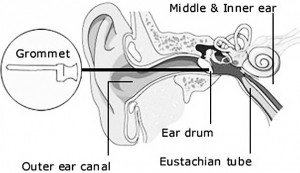Grommets are usually inserted to treat ‘glue ear’ (fluid in the middle ear) or prevent recurrent otitis media (middle ear infection). A grommet is a small ventilation tube inserted into the eardrum to allow air into the middle ear and prevent a build-up of fluid.
The operation
During the operation, a surgeon will make a small cut in the eardrum and the fluid in the middle ear will be sucked out. The grommet is then inserted. Your child will be in the Operating Room Suites for about 30 to 45 minutes. This includes the anaesthetic, the operation and time spent in the recovery room. Your child should be well enough to go home within two hours of the operation.
After the operation
If the ear is particularly inflamed, you may notice bleeding from the ear on the day of the operation or for some fluid discharge to continue for a day after the operation. This is not unusual. Simply clean the outside of the ear as required but never insert anything into the ear canal.
Pain relief
Your child may experience a mild earache in the first few weeks after the operation. It is important to provide regular pain relief during their recovery. Nursing staff will discuss suitable medications for your child before you go home. Medication such as paracetamol (Panadol©, Dymadon©) should relieve your child’s pain. Follow directions on the label to ensure your child is given the correct dose for their age/weight.
Aspirin must NOT to be given to your child.
If there is persistent pain or problems, contact your GP or the Queensland Children’s Hospital.
Food and drink
Aneasthetic can sometimes leave a child feeling nauseous and with no appetite. When your child feels hungry, he/ she can eat something light (a sandwich). Most children resume their usual diets the next day.
If your child experiences nausea or vomiting at home, stop food and fluids for one hour. They should then sip clear fluid and eat a small amount of dry food such as plain toast or a biscuit.
Bathing/hair washing
After the operation, it is important to keep water out of the ears to prevent infection. Ear plugs, ear putty, swimming caps and ear wraps can be used to keep water out of ears.
Complications
The most common complication is infection, which can be signified by a discharge from the ear. If this occurs, contact your GP or the Emergency Department of your nearest hospital immediately.
Post-operative check-up
Your child will have a post-operative check-up 6 to 8 weeks after the operation. If you have any concerns prior to the appointment, contact us. Grommets will usually fall out of the eardrum in 6 to 12 months
When to seek help
In an emergency, call Triple Zero (000) and ask for an ambulance.
If you're not sure whether to go to an emergency department, call 13 HEALTH (13 43 25 84) and speak to a registered nurse.
Developed by the Ear, Nose and Throat Outpatients Department, Queensland Children’s Hospital. We acknowledge the input of consumers and carers.
Resource ID: FS004. Reviewed: February 2015.
Disclaimer: This information has been produced by healthcare professionals as a guideline only and is intended to support, not replace, discussion with your child’s doctor or healthcare professionals. Information is updated regularly, so please check you are referring to the most recent version. Seek medical advice, as appropriate, for concerns regarding your child’s health.
Last updated: October 2023
